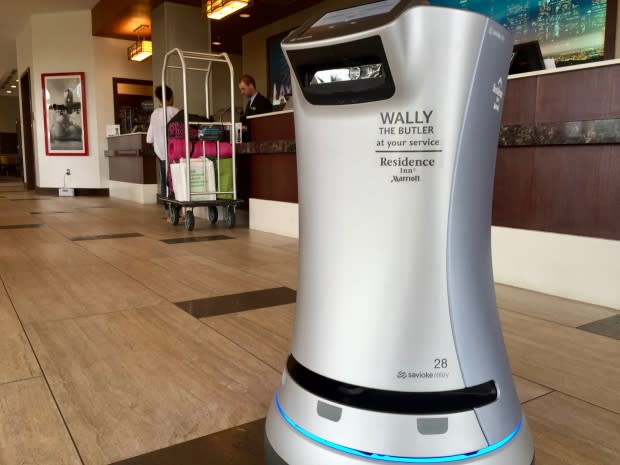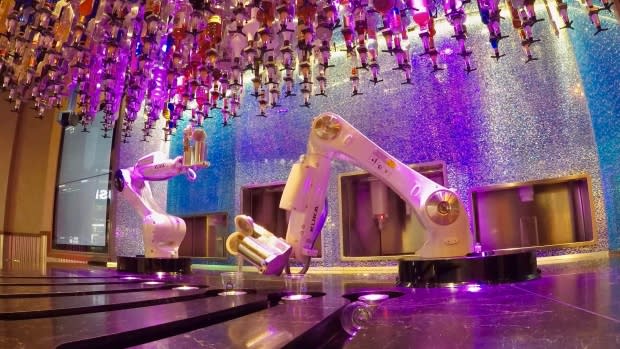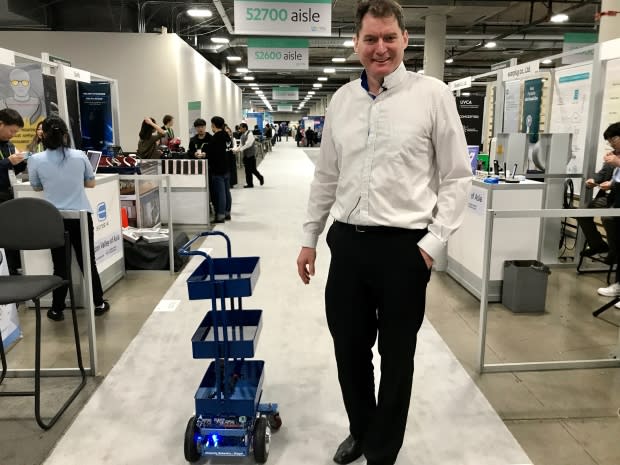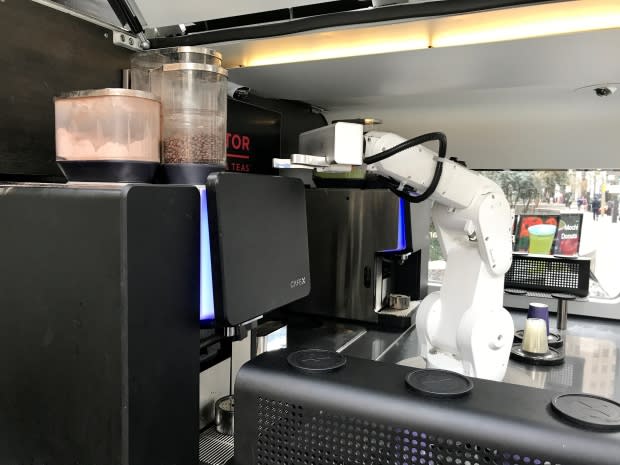Is a robot coming for your job? Change comes quickly in the era of automation
It was like "having R2-D2 show up at your door," according to Latausha McDowell.
After settling into her room at the LAX Residence Inn following a tiring journey from Odessa, Texas, the 42-year-old ordered a ginger ale from the hotel lobby. Five minutes later, Wally the bellhop was at her door.
But there was no need to tip: After McDowell grabbed her drink, Wally beeped, closed its lid, remotely summoned the elevator, and rolled slowly back down the hallway, its blue LED lights illuminating its path like a souped-up hatchback with a neon underglow.
"This is very cool. I love it," said McDowell. "I'm from Texas, so I love hospitality and interacting with people, but as far as the mundane things, like bringing up a towel or toiletries … great, give it to the robot. We should all be working with robots."
McDowell may get her wish sooner than she realizes. Wally, an autonomous service robot designed by the San Jose-based robotics company Savioke, is among a growing army of robots that is reshaping our workplaces.
According to the International Federation of Robotics, sales of professional service robots — loosely defined as a robot that performs useful tasks for humans in a non-industrial setting — increased 32 per cent in 2017 to reach almost $9 billion US.
That's expected to rise to almost $15 billion in the next two years, prompting many workers to ask themselves: Is a robot coming for my job?
Glitz and gadgets in Sin City
At the Tipsy Robot in Las Vegas, the two steel bartenders can't listen to your troubles — but they will mix a cocktail in 90 seconds or less. The robotic arms sluice the alcohol and various ingredients into their shakers, give them a mix and then pour the drinks into plastic cups, where a conveyor delivers them to waiting patrons.

"The irony is you would think because they're robots, it would be cheaper. But the drinks are actually twice as expensive," customer and Ottawa native Phil Giroux said with a laugh.
Giroux, who was better known in the '90s as Tom Green's sidekick on that eponymous show, is in Las Vegas with a few colleagues from an Ottawa-based IT company. As Giroux watches the robot twist and shake the group's drinks, he's impressed by the technology — but can hear the bell toll for human mixologists.
"If you're in the bartending industry … look out," he said.
But the bar's general manager, Victor Reza Valanejad, says he thinks there will always be a place for people at the Tipsy Robot: Jobs won't disappear, he says, they will evolve.
"[They're] going to be behind the computer, running the robots instead of being behind the bar," Valanejad said. "It's not going to take jobs because they cannot work without humans. You still need humans to just to make sure that everything is going OK."
For instance, he says, the current iteration of the robot bartender can't replace the bottles of booze that hang overhead when they run dry. And it doesn't have enough dexterity to reliably grip a cup, which is why drinks come out on a conveyor.
But the company is already working on a new model that will solve many of these challenges. And these rapid advances in robotics could have profound implications for the region's labour force.
A 2017 report by the Institute for Spatial Economic Analysis (ISEA) suggests that two-thirds of all jobs in Las Vegas will most likely be automated by 2035.

That's why the local Culinary Workers Union, representing almost 60,000 of the city's hospitality workers, negotiated groundbreaking language in its latest contract, aimed at protecting its members from the effects of automation: Workers displaced by automation will receive job retraining, and those that can't be retrained will get severance pay and benefits for sixth months.
Sin City's economy is particularly susceptible to automation, with more than 300,000 people working in the gaming and hospitality industry. But according to roboticist David Crawley, Las Vegas isn't completely an outlier. Technology is advancing so quickly, he says robots could eventually be doing a lot of the work many people are doing right now.
Robotics field rapidly advancing
On a trade show floor in Las Vegas, Crawley picks up his phone, presses a button and says "find person." The robot he helped design — picture a small, blue shopping cart with letter trays — swivels, rolls forward and stops in front of him.
Known as "Magni," the robot can be customized and programmed to become anything from a porter to a cocktail waiter.
"The robot has a neural net which is a little bit like a human brain," said Crawley, who is co-founder of Ubiquity Robotics.
"Right now you hire a person because he can interact with objects; he knows where he is — and that's been a real barrier to robots up to this point," he said. "Now they're able to move things from one place to another, they're able to interact with objects and do the sorts of things that humans can do, and that's going to displace human work."

Robots have already made significant inroads in factories and warehouses, Crawley says. He believes receptionists and other office workers will be the next to be displaced.
"The mundane jobs that humans do, robots will take those over," he said.
Almost everyone who represents companies that rely on robots are keen to emphasize that metallic workers are only meant to help — and not replace — the squishy ones that get paid breaks and health benefits. But not Henry Hu.
Robots for the 'boring' work
On a street corner in San Francisco stands one of the only coffee shops in the United States run by a robot. Inside the artfully designed street-front kiosk called Cafe X, a robot known as "Robin" twirls and gyrates as it waits for a customer to order a coffee via a touchscreen mounted a few feet away.
"It likes to wave and dance," said Hu, laughing. "It has like several different dance routines."

The 25-year-old said he came up with the concept of Cafe X because he spent a lot of time "waiting in line at coffee shops" for baristas whose jobs seemed mostly comprised of factory worker-like mechanical functions.
"A lot of what the baristas are doing is moving cups around," Hu said. "They're basically shuffling cups and pushing buttons on machines."
Using robots to do the "boring" work allows the one or two human employees standing outside the kiosk to focus on customer service, Hu says. But in an unusually frank admission, he says that by using robots, Cafe X is able to reduce one of the highest costs of any coffee chain.
"Certainly it gives us the flexibility to adjust the amount of labour we have on sites because the basic functionality of making drinks is done by robots," he said. "So that is one of the things that makes it more economical for us to scale really quickly."

Thanks to this robot-centric business model, Cafe X will look to expand beyond its existing three San Francisco locations this year, and plans to expand into more cities in the next year or so in its quest to "to grow as fast as possible."
Is this type of automation the way of the future? "I think it's pretty obvious it is," Hu says.
A 2018 study by the Brookings Institution supports Hu's take, suggesting that by 2040, 91 per cent of jobs in the food preparation industry could be done by robots.
And a 2017 report by the McKinsey Global Institute found that 50 per cent of the global workforce could be automated by 2055, with the job functions that are most susceptible to automation today accounting for 51 per cent of the U.S. economy, representing $2.7 trillion in wages.
Time for a robot 'tax'?
Some thinkers, like Bill Gates, have suggested a "robot tax" to offset the costs of retraining workers displaced by technology. The idea hasn't gathered momentum in the U.S. yet, but South Korea introduced in 2017 what has been called the world's first "tax" on robots. (It's not actually a direct tax: The South Korean government instead reduced the tax deduction given to businesses that invested in automation.)
Others in Silicon Valley believe a "robot tax" would stifle innovation.
Crawley says we shouldn't panic about the threat posed by robots, as history suggests that, overall, automation will create more jobs than it destroys.
"What's always happened is that when it displaces jobs, it creates new jobs in other segments — usually work that's more interesting, more fun and pays better. So there's going to be some shifts, but at the end of the day, we're all going to be better off."
But Crawley also admits there's bound to be some "painful transitions" along the way.

